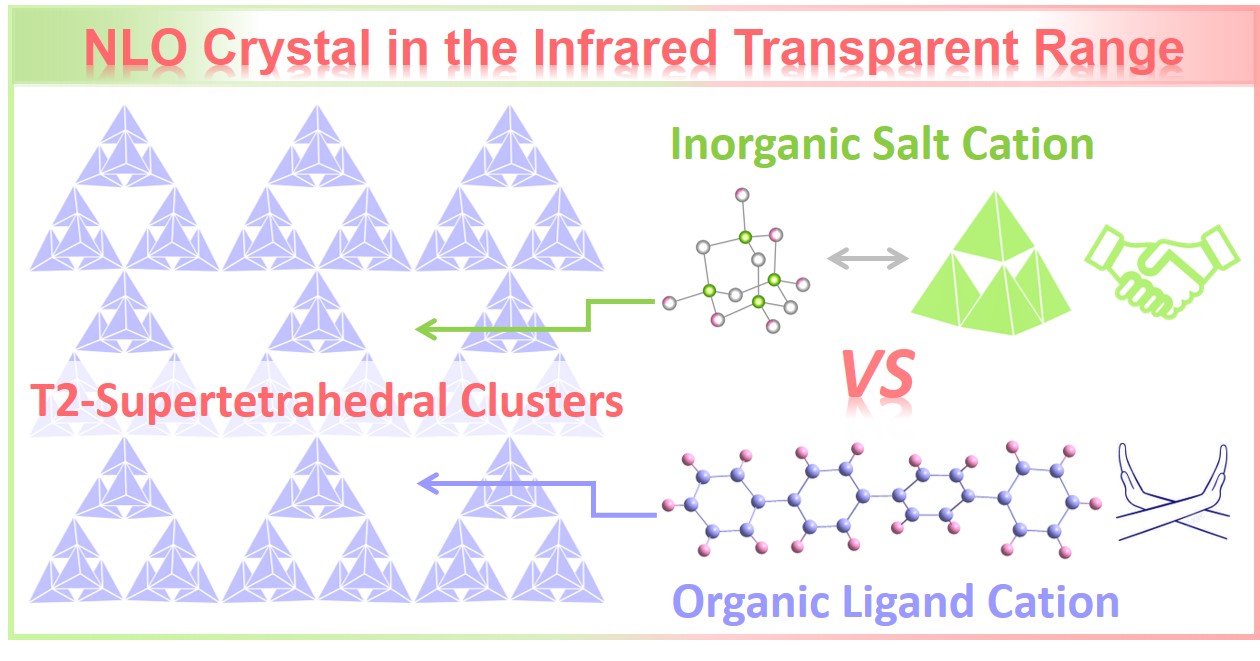As core components for generating coherent tunable radiation sources in all-solid-state lasers, second-order nonlinear optical (NLO) crystals have demonstrated significant technical advantages in cutting-edge fields such as environmental remote sensing monitoring, molecular spectroscopic analysis, and the development of multifunctional optoelectronic devices. Metal chalcogenides with tetrahedral cluster (Tn) as the structural unit are regarded as candidate systems for NLO materials of the mid- and far-infrared bands due to their potential strong second-harmonic-generation (SHG) response and wide infrared transmission range.
However, Tn anionic clusters usually tend to coordinate with organic ligand cation, forming common tetrahedral-based organic-inorganic hybrid materials. Due to the presence of organic functional groups, these materials inevitably exhibit characteristic vibrational or rotational absorption peaks in the infrared spectrum, which is contrary to the goal of designing NLO materials with infrared transmission.
In a study published in Angewandte Chemie International Edition, Prof. GUO Guocong and Prof. LIU Binwen from Fujian Institute of Research on the Structure of Matter, Chinese Academy of Sciences, proposed an innovative strategy, which involves using inorganic (X4K8Ba2)8+ (X = Cl, Br) cations with a T2-supertetrahedral configuration to replace traditional organic ligand cations as structure-directing agents. They combined these with T2-(In4Se10)8− T2-supertetrahedral clusters to construct two new three-dimensional salt-inclusion chalcogenides, namely [K4BaX2][In6Se11] (X = Cl, Br).
The isolated (X4K8Ba2)8+ polycation has a high positive charge density and an appropriate size, which not only effectively meets the charge balance requirements of the T2-supertetrahedral anion clusters but also significantly promotes the construction of a three-dimensional anionic framework.
Importantly, inorganic salt polycations are typically characterized by chemical bond vibrations and multi-phonon absorptions, with their absorption frequency bands significantly extending beyond the mid- and far-infrared regions, thereby demonstrating excellent properties with a wide infrared transparency range.
The optical properties measurements showed that both of the two salt-inclusion chalcogenides exhibit significant phase-matching SHG intensity (2.2−2.4 × AgGaS2 @1910 nm), which is mainly attributed to the parallel alignment of the NLO functional motif T2-(In4Se10)8− clusters. Additionally, the moderate optical band gap and low thermal expansion coefficient jointly contribute to [K4BaCl2][In6Se11] showing a high laser-induced damage threshold (4.7 × AgGaS2 @2090 nm).
Besides, [K4BaCl2][In6Se11] achieves an infrared transparency range as wide as 0.7−18.1 µm, which is closely related to the introduction of the (Cl4K8Ba2)8+ polycation.
This study provides a feasible research approach for designing NLO materials with both excellent SHG response and wide infrared transparency range.

Structural design concept for [K4BaCl2][In6Se11] featuring a wide infrared transparency range.(Image by Prof. GUO’s group)
Contact:
Prof. GUO Guocong
Fujian Institute of Research on the Structure of Matter
Chinese Academy of Sciences
Email: gcguo@fjirsm.ac.cn